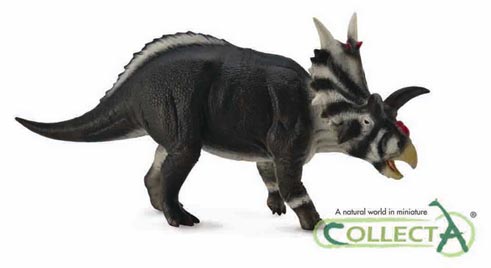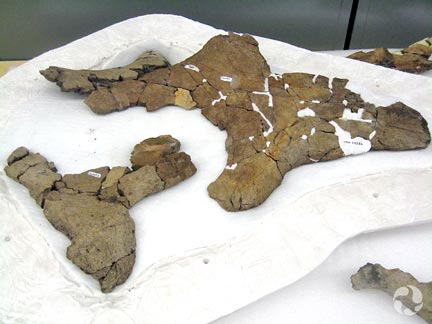Six-Metre-Long “Alien Horned Face”
Xenoceratops foremostensis is a surprise omission from “The Princeton Field Guide to Dinosaurs” (second edition), a new dinosaur book that an Everything Dinosaur team member is writing a review about*. With all the amazing new, North American ceratopsid discoveries over the last decade or so we thought that “alien horned face” would be featured. Perhaps it is, but so far, we have not been able to find it, in what is a very well-presented and beautifully illustrated guide to the Dinosauria.
A Scale Drawing of the Horned Dinosaur Xenoceratops
Picture credit: Everything Dinosaur
Fragmentary Skull Fossils
Fragmentary skull pieces were collected by Dr Wann Langston from the uppermost layers of the Foremost Formation (south-western Alberta, Canada) in 1958. Dinosaur fossils are exceptionally rare in this strata and what fossils have been found are highly fragmentary or represent individual, shed teeth. To understand why, you have to consider how the majority of the rocks that make up this Upper Cretaceous sequence, which is regarded as a basal component of the Judith River Group, were laid down in the first place.
The sandstones, mudstones and shales that make up the majority of the strata (there are coal seams too), consist of sediments that were eroded from the mountain range on the west of the landmass of Laramidia. Rivers transported these sediments travelling eastwards before eventually dumping much of their load as the water courses slowed on a large floodplain prior to an estuarine habitat that led out onto the Western Interior Seaway. The fossils ascribed to Xenoceratops were found in a small band of rock which represented a riverine deposition area close to the shoreline. These unimpressive, scrappy remains were put into storage and not examined again until 2003.
Xenoceratops foremostensis
We have palaeontologists Dr Michael Ryan, Dr David Evans and Kieran Shepherd, the curator of palaeobiology at the Canadian Museum of Nature, to thank for the scientific description of this centrosaurine, one of the oldest (if not the oldest), horned dinosaurs known from Canada. A thorough examination of the fossil material was begun in 2009 with Dr Evans locating further fossil material to be used in the study. This led to the naming of Xenoceratops (Xenoceratops foremostensis) in 2012.
CollectA Added a Xenoceratops Replica to the “Prehistoric Life” Model Range in 2014
To view the CollectA Xenoceratops dinosaur model and the rest of the models that make up the wonderful CollectA “Prehistoric Life” model collection: CollectA Age of Dinosaurs Popular Figures.
Studying Xenoceratops
Contrary to popular belief, this dinosaur was not named “alien horned face” because of its bizarre headshield ornamentation and its huge nasal horn. It was the first ceratopsian to be described from the Foremost Formation and as it was a rarity, it was regarded as “alien” to the strata of south-western Alberta.
The Fragmentary Skull Fossils of Xenoceratops
Picture credit: Canadian Museum of Natural History
* To read Everything Dinosaur’s review of “The Princeton Field Guide to Dinosaurs”: “The Princeton Field Guide to Dinosaurs” Reviewed.









Leave A Comment